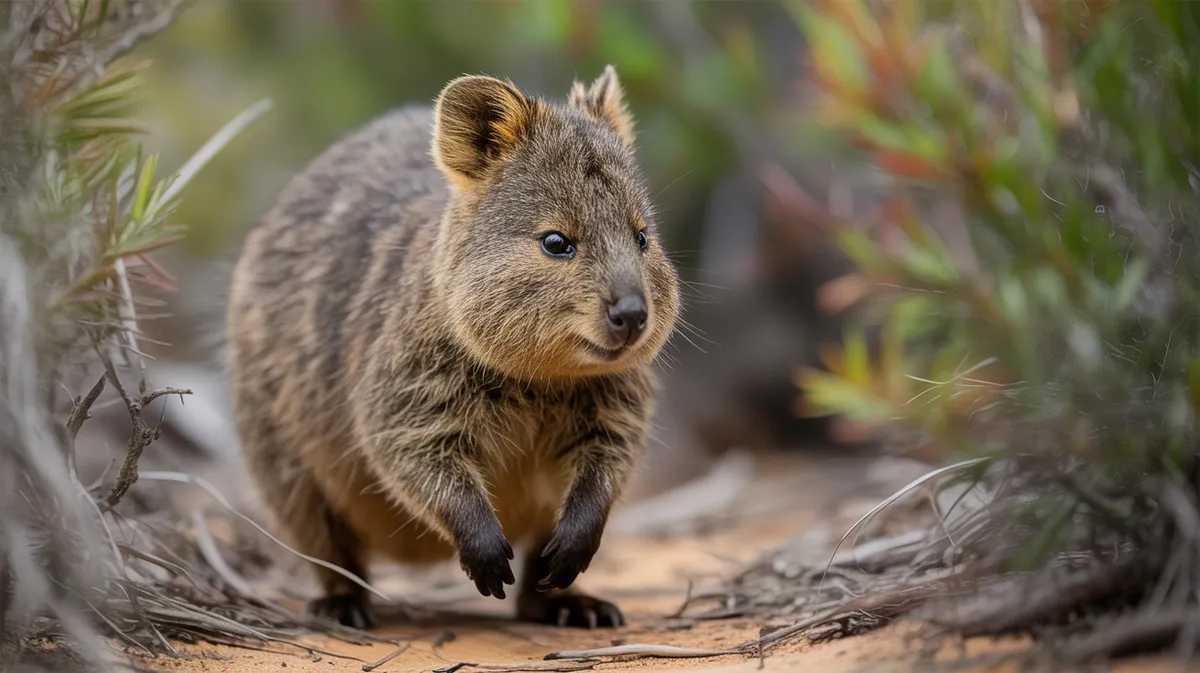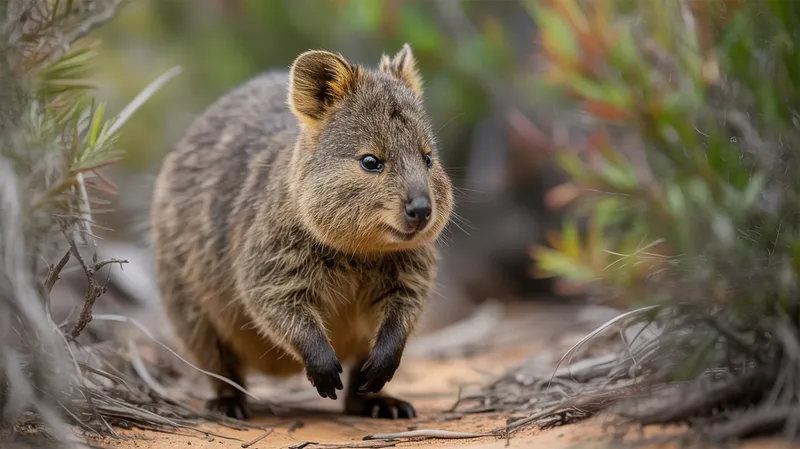
Quokka
Setonix brachyurus

Meet the Quokka
The Quokka is a small marsupial native to southwestern Australia, most famously found on Rottnest Island. Known for their friendly nature and 'smiling' appearance, quokkas possess rounded faces, short ears, and a compact, stocky build. They are nocturnal, spending their nights foraging for vegetation and their days sheltering in dense undergrowth. Despite their cute look, they are wild animals and have adapted to survive in harsh, low-water environments. Populations on the mainland are declining, but they remain relatively secure on offshore islands.
Classification
Mammal
Habitat
Dense vegetation in coastal scrublands, woodlands, and island forests
Diet
Herbivore
Lifespan
10-12 years
Conservation
Vulnerable
Weight
2.5-5 kg
📖Fascinating Facts
Herbivorous Diet
Quokkas feed mostly on grasses, leaves, stems, and bark, and are well-adapted to consuming tough, fibrous plants found in their habitat.
Famous Smile
Their friendly and seemingly smiling faces have made them a popular subject for selfies and social media, but handling or feeding them is illegal to protect their welfare.
Unique Marsupial
Unlike many marsupials, quokkas are capable climbers, sometimes ascending small trees or shrubs in search of food.
📋Detailed Description
The quokka (Setonix brachyurus) is a small, robust marsupial with a head-and-body length of 40–54 cm and a short, thick tail measuring 25–31 cm. Adults typically weigh between 2.5 and 4.5 kg, with females slightly smaller than males. Their dense, coarse fur is grey-brown with lighter underparts, and their rounded faces, large dark eyes, and short, rounded ears contribute to their characteristic 'smiling' appearance. Quokkas possess strong hind limbs adapted for hopping, though their gait is less powerful than larger macropods. They are primarily nocturnal and crepuscular, sheltering in dense vegetation during the day and emerging at dusk to forage. Socially, quokkas are semi-gregarious, forming loose groups around abundant food sources or shelter sites, but do not exhibit strong territoriality. Their diet consists mainly of native grasses, sedges, succulents, and leaves, and they are known to climb small shrubs to access foliage. Quokkas have a unique ability to survive in environments with scarce free water, obtaining most of their hydration from their food and displaying remarkable tolerance to dehydration. Their populations are fragmented, with the largest and most stable group found on Rottnest Island, while mainland populations are highly localized and vulnerable.
💡 Did you know?
Quokkas can breed twice a year and, like other marsupials, can pause embryo development if conditions are unfavorable—a process called embryonic diapause.
🔬Research & Sources
Wikipedia Summary
The quokka is a small macropod about the size of a domestic cat. It is the only member of the genus Setonix. Like other marsupials in the macropod family, the quokka is herbivorous and mainly nocturnal.
Last Modified: 5/23/2025
🎭Behavior & Social Structure
Quokkas are primarily nocturnal, becoming active at dusk and foraging throughout the night. They are opportunistic herbivores, feeding on a variety of plant materials, including grasses, leaves, stems, and occasionally fruits. Foraging is often solitary, but individuals may aggregate in areas with abundant resources. Quokkas use well-defined runways through dense vegetation to move between shelter and feeding sites. They exhibit a range of vocalizations, including soft grunts and hisses, especially during aggressive interactions or when threatened. Social interactions are generally peaceful, though competition for food or shelter can lead to brief skirmishes. During the day, quokkas rest in cool, shaded areas, often in dense thickets or under low shrubs, to avoid heat stress. They are known for their curiosity and tolerance of humans, particularly on Rottnest Island, but remain wary and will retreat if threatened.
👶Reproduction & Life Cycle
Quokkas breed year-round, but peak reproductive activity occurs between January and March. Females typically give birth to a single joey after a gestation period of about 27 days. The tiny, underdeveloped joey crawls into the mother's pouch, where it continues to develop for approximately six months. After leaving the pouch, the young remains dependent on the mother for another two to three months, suckling and sheltering nearby. Quokkas are capable of embryonic diapause, allowing them to delay the development of a second embryo until the first joey leaves the pouch or is lost. Females can produce up to two offspring per year under favorable conditions. Sexual maturity is reached at around one year of age. Parental care is provided exclusively by the mother, with no involvement from males.
🛡️Adaptations & Survival
Quokkas exhibit several adaptations to their arid and variable habitats. Their low metabolic rate and ability to derive moisture from succulent plants allow them to survive extended periods without free water. They possess a highly efficient digestive system, with a large, complex stomach that ferments fibrous plant material, maximizing nutrient extraction. Behavioral adaptations include nocturnal and crepuscular activity patterns to avoid daytime heat and water loss. Quokkas are also capable climbers, enabling them to access food above ground level. Their reproductive strategy, including embryonic diapause, ensures that offspring are only born when environmental conditions are suitable. Dense fur provides insulation against temperature extremes, and their cryptic coloration offers camouflage from predators.
🎨Cultural Significance
Quokkas have become internationally recognized as symbols of Australian wildlife, largely due to their approachable demeanor and photogenic 'smiles,' leading to a surge in 'quokka selfies' on social media. They are a key attraction for tourism on Rottnest Island, contributing significantly to the local economy. In Noongar Aboriginal culture, quokkas are known as 'kwoka' and feature in traditional stories and as a food source prior to European settlement. Their positive public image has been leveraged in conservation campaigns, though increased human interaction has also raised concerns about inappropriate feeding and handling.
🔬Recent Research & Discoveries
Recent research has focused on quokka population genetics, revealing low genetic diversity in island populations, which may impact long-term resilience. Studies on their dietary ecology have highlighted their reliance on specific native plants and vulnerability to habitat changes. Ongoing research includes monitoring population trends using camera traps and GPS tracking, investigating the impacts of climate change and fire management, and assessing disease risks such as toxoplasmosis and salmonellosis. Conservation programs are exploring translocation and habitat restoration to bolster mainland populations. Behavioral studies have also examined the effects of tourism on quokka stress levels and health.
🎥Wildlife Videos

The Truth About The Happiest Animals In The World - Quokka Documentary
The Best Quokka Video you'll ever see! Everything you've ever wanted to know about The Happiest Animal in the World ...
Daxon

Quokkas | The Happiest Animals on Earth | Animals Planet HD
Quokkas | The Happiest Animals on Earth | Animals Planet HD Description: Meet the Quokka – The World's Happiest Animal!
Animals Planet HD

How Did Selfies Save the Cute Quokka? | Nat Geo Wild
#NatGeoWILD #Quokka #Selfies About National Geographic Wild: National Geographic Wild is a place for all things animals and ...
Nat Geo Animals

Spy Quokka Meets a Joey
Spy Quokka meets a 3-month-old joey, tucked in his mother's pouch. Please LIKE and SUBSCRIBE if you enjoyed it!
Nature on PBS

Wildlife | Episode 3: Kangaroos - Kings of the Outback | Free Documentary Nature
Wildlife - Episode 3: Kangaroos - Kings of the Outback | Wildlife Documentary Watch 'Wildlife - Episode 4: World's Largest Land ...
Free Documentary - Nature

😄 Meet the Quokka: The Happiest Animal on Earth! 🐾
Meet the Quokka: The Happiest Animal on Earth! Welcome to Ases World! Immerse yourself in the captivating world of wildlife ...
Ases World
🌍Habitat Information
The Quokka typically inhabits Dense vegetation in coastal scrublands, woodlands, and island forests environments. Quokkas have adapted to their environments with specialized features and behaviors.
Primary Habitat:
Dense vegetation in coastal scrublands, woodlands, and island forests
More detailed habitat information will be available soon.
🛡️Conservation Status
The Quokka is currently classified as Vulnerable. Conservation efforts are crucial for preserving this species for future generations.
Common Threats:
- 🏠Habitat loss and fragmentation
- 🌡️Climate change impacts
- 🎯Hunting and poaching
- 🏭Human-wildlife conflict
⚠️Threats & Conservation Challenges
The primary threats to quokka populations include habitat loss and fragmentation due to land clearing, urban development, and agriculture. Introduced predators such as foxes (Vulpes vulpes), feral cats (Felis catus), and dogs have caused significant declines, particularly on the mainland. Frequent fires and changes in fire regimes can destroy critical shelter and food resources. Disease, road mortality, and illegal feeding or handling by tourists also pose risks. While the Rottnest Island population is relatively secure due to the absence of introduced predators, mainland populations are small, isolated, and declining. Conservation challenges include maintaining habitat connectivity, controlling invasive species, and managing human-wildlife interactions. The IUCN currently lists the quokka as Vulnerable, with an estimated total population of 7,500–17,000 mature individuals.
🔬Scientific Classification
Scientific Name
Setonix brachyurus
Classification Hierarchy
🔍 About Taxonomic Classification
Taxonomic classification is a hierarchical system used by scientists to classify and organize living organisms based on shared characteristics and evolutionary relationships.
The system moves from broad categories (Kingdom) to increasingly specific ones, with each animal's scientific name typically consisting of its Genus and species.
📝Community Notes
Share your observations and insights about the Quokka with our community of wildlife enthusiasts.
Join Our Community
Sign in to share your observations and connect with fellow wildlife enthusiasts.
Sign In to ContributeNo community notes yet
Be the first to share your observations about the Quokka!
Explore Quokka
Select a tab above to learn more about this amazing animal.
📸Photo Gallery
No photos available for this animal yet.
🌟Discover More Wildlife
Continue your journey of discovery with more fascinating animals from our database
